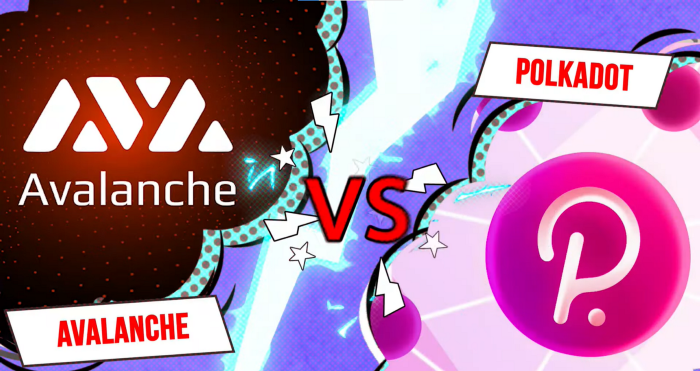
Today’s article will talk about the altcoin rivalry between Avalanche and Polkadot. Both of whom are vying to replace Ethereum as its killer. We have already talked about comparisons between altcoins in this space on other articles I’ve done. And if you want to check out those articles, go to my stories.
Avalanche
Avalanche (AVAX) is a blockchain ecosystem that was designed to function as a secure, globally distributed, decentralized network. The project has been referred to as a “platform of platforms” by its developers. Uniquely, the protocol leverages three distinct blockchains to create an interoperable and trustless framework for developers to build upon. Additionally, Avalanche offers payment solutions in the form of a cryptocurrency (AVAX).
Polkadot
Polkadot is a multi-chain application environment that enables cross-chain interoperability on a level previously unimaginable. Specifically, Polkadot allows users to send more than just tokens across blockchains. Polkadot allows these networks to communicate actual data. Polkadot attempts to tackle one of the most pressing issues facing the blockchain sector, interoperability. Currently, the market is in a state of extreme compartmentalization. Blockchains function as separate islands of data with little way of leveraging the information the other networks posses. Polkadot eliminates these concerns through the integration of a variety of proprietary technologies. Notably, Polkadot is even able to communicate information from private blockchains to public networks and vice versa.
Scalability|
- Avalanche
Now, Scalability Avalanche is capable of roughly 4,500 transactions per second. Based on low hardware requirements of just two CPU cores and four gigabytes of memory. And with also, of course, a validator capacity of over 2,000 nodes. Not bad! Performance is CPU bound, and if better performance is desired, more specialized Subnets with higher minimum needs can be constructed to achieve 10,000 plus TPS within a Subnet. Now Avalanche intends to have thousands of interoperable Subnets with several virtual machines or blockchains. The number of Subnets that can be built is completely unlimited.
- Polkadot
Now Polkadot Parachains can also handle up to about 1500 transactions per second. The performance of a Parachain is split between multiple Parathreads offering lower performance and competing between themselves in a per block auction to have their transactions included in the next Relay Chain block. The limit on the number of parachains depends on the number of validators in the Relay Chain. They intend to attain 100 total Parachains due to its ability to issue Parachains crypto developers would no longer need to build their blockchains. And can just use Polkadot’s existing infrastructure, as I mentioned.
Now Avalanche, with its higher transactions per second, has no limit on the number of Subnets or blockchains that can be created and the snowball consensus can scale to potentially millions of validators worldwide participating in consensus scores more than Polkadot.
Decentralization|
- Avalanche
Now decentralization Avalanche consensus can scale to tens of thousands or even millions of validators through repeated sub-sampling. Now the more validators there are, the faster the network grows. Anyone can run a node, and there is no limit to the number of Subnets or virtual machines built.
- Polkadot
Now Polkadot contains 1,000 validators in the Relay Chain. Each is validating a Parachain with a minimum of 14. The Relay Chain is a single point of failure because all Parachains connect to it, and the number of validators is limited. They hope to achieve 100 total Parachains, as I mentioned. And to win an auction to lease a Parachain space for up to 24 months or two years, which is a considerable amount of dot that will need to be purchased to lock up. So only projects with merit decided by the people will be able to afford a Parachain slot. Now Parathreads are an alternative for those who need less performance and can’t get a Parachain slot.
Latency
- Avalanche
Now Latency Avalanche consensus achieves finality within three seconds, with most happening in sub-one seconds immutable and completely irreversible. Each Subnet can connect directly to another without going through multiple hops. Any VM can contact to another VM within the same Subnet and external Subnets.
- Polkadot
Polkadot provides a hybrid consensus protocol consisting of block producing protocol called ‘’Babe’’ which stands for blind assignment for blockchain extension. And a finality gadget called ‘’Grandpa’’ to choose a chain from several alternative forks using a simpler fork choice rule. Rather than voting on each block, it agrees on chains when two out of three validators swear to a chain containing the block. The blocks are before it is finalized.
Shared Security|
- Polkadot
Polkadot requires shared security since it employs a shared state between the Relay Chain and all associated Parachains. If the Relay Chain must revert, then all Parachains must revert. The Relay Chain validates state transitions and facilitates seamless interoperability between Parachains by sharing trust, assumptions. In return, they must buy DOT and win an auction for one of the available Parachain slots.
- Avalanche
In Avalanche, a Subnet is a dynamic set of validators who collaborate to reach a consensus on the state of a collection of numerous different blockchains where complicated rule sets can be configured to satisfy regulatory compliance. Now, in contrast to Cosmos, where each zone and hub has its validators, a Subnet can validate a single or several virtual machines or blockchains using a single validator set. Shared Security is optional. So Polkadot wins this round as shared security goes and is mandatory and is built into a key decision and design by Polkadots infrastructure.
Interoperability|
- Polkadot
Interoperability is supported between Parachains via the Xcmp protocol and with other systems using bridges that are specially constructed Parachains or Parathreads to communicate with other ecosystems like Ethereum and Bitcoin. This is coming soon as part of the EVM Parachain you may have heard of called Moonbeam. Maybe you’ve heard about it. Finality time between parachutes is roughly 60 seconds. However, connecting to external blockchains will take longer. Now the Whitepaper estimates it could be up to 60 minutes. So Polkadot can only connect two external systems, but the foundation is limitless. Polkadot also has a limited number of Parachain slots, restricting the number of bridge blockchains. Parathreads could be utilized for slower bridges, but future blockchains will be faster.
- Avalanche
Now Avalanche uses the same trust assumptions for all blockchains inside a Subnet but differing levels of trust between Subnets. However, because the primary network comprises all validators, it can be utilized to establish trust. Avalanche also offers a substantially faster finality time and has no limit on the amount of blockchains, Subnets or bridges that may be constructed. So, in this case, I will put Avalanche a little ahead as far as the barrier to entry for new node operators, and it’s much more accessible.



















